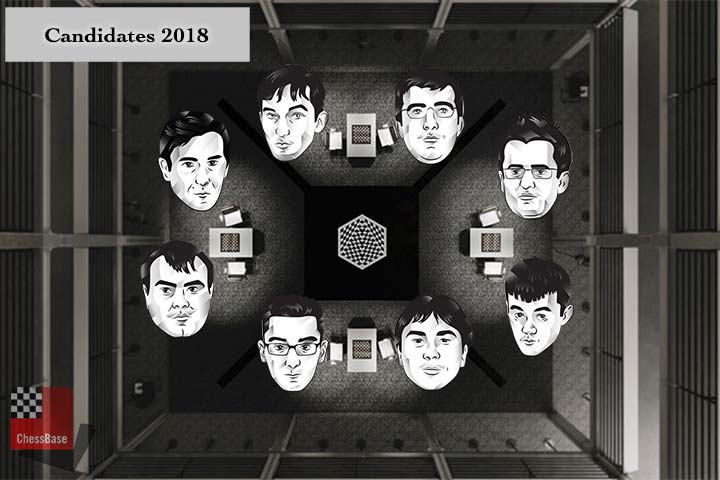Candidates in the "cool house"
This evening, the opening ceremony will kick off the 2018 Candidates Tournament in Berlin. Eight players compete in a double round-robin to determine the challenger for the next World Championship match against Magnus Carlsen.
The first round will take place on Saturday, March 10th, starting at 15:00 CET (9:00 AM EST). After every three rounds, there is a rest day, with the final fourteenth round scheduled for March 27th. In theory, there could be a tiebreak played on March 28th, but the mathematical tiebreak system makes that virtually impossible.
The prize fund is 420,000 euros. Of this, the winner gets 95,000 euros, second place receives 88,000 euros, and third, 75,000 euros. The eighth and last of the tournament will take home 17,000 euros.
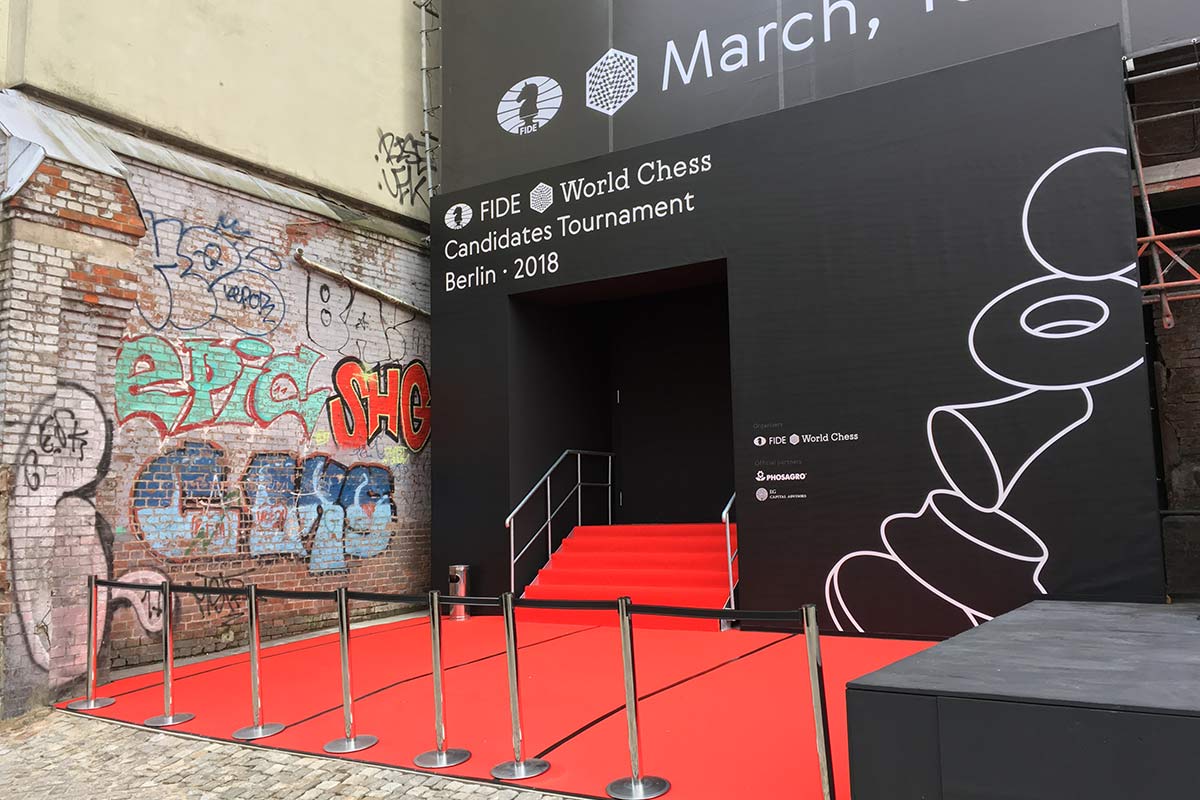
They've rolled out the red carpet in Berlin | Photo: Macauley Peterson
Who and why: the players in order of rating
(Portrait sketches by Mariya Yugina. Click or tap to expand.)

Shahkriyar Mamedyarow, 32, Azerbaijan, Elo 2809, World rank: 2, qualified via the Grand Prix
Vladimir Kramnik: World Champion 2000-2007, 42, Russia, Elo 2800, World rank: 3, Wildcard

Wesley So: 24, USA, Elo 2799, World rank: 4, qualified by rating
Levon Aronian: 35, Armenia, Elo 2794, World rank: 5, qualified as World Cup winner
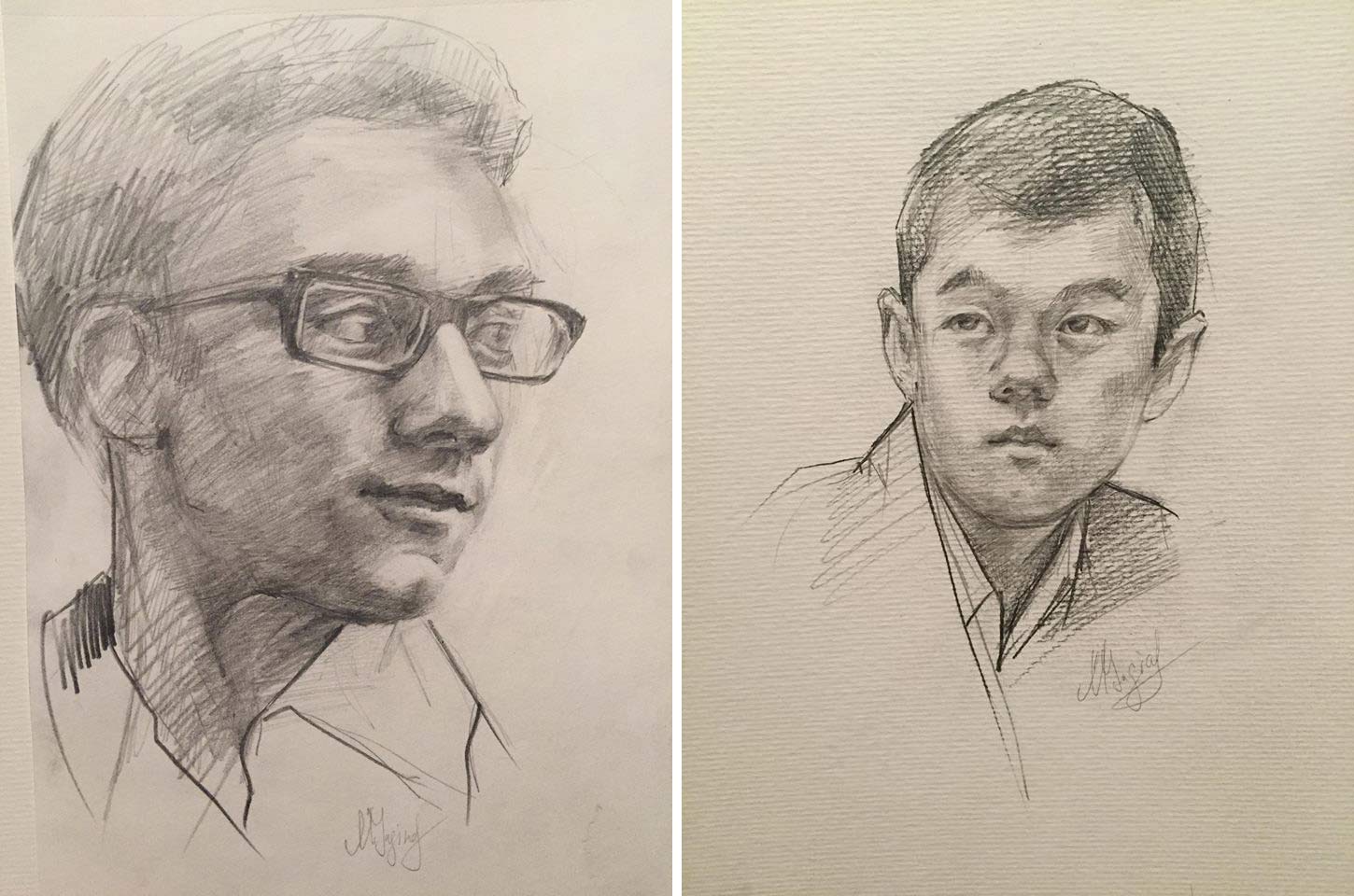
Fabiano Caruana: 25, USA, Elo 2784, World rank: 7, qualified by rating
Ding Liren: 25, China, Elo 2769, World rank: 11, qualified as World Cup runner-up

Alexander Grischuk: Russia, 34, Elo 2767, World rank: 12, qualified via the Grand Prix
Sergey Karjakin: 28, Russia, Elo 2763, World rank: 13, qualified as the previous challenger
One will win
As you can see, five of these players are among the current top ten, and the other three are not far away: Ding (11), Grischuk (12), Karjakin (13).
A slight favourite in the eyes of many is Levon Aronian. Aronian has participated in a number of Candidates matches and tournaments before, and has always been considered one of the favourites, but he has never been able to qualify. "Always a bridesmaid, never a bride". Is it the nerves? But maybe this year will be different; of the eight candidates, the Armenian is the closest to a "Berliner", having lived in the city and played for Berlin's Bundesliga team. Many Berlin chess friends know him from this time will keep their fingers crossed for him.
In the last Candidates tournament, Fabiano Caruana was among the most promising candidates. And was a few moves away from qualifying, but in the end, Serey Karjakin prevailed. Wesley So has had a tremendous rise in recent years. The US-based Filipino sometimes starts out flying high but quickly comes down to earth.
Of course, Shakhriyar Mamedyarov is at the top of the world rankings among the players. He gained a momentum in the past year and his chess has "grown up," as the Azerbaijani player himself judged in a recent interview. Ding has already achieved everything with the team. Can he also refill in the individual?
Ding Liren's participation is the first time in the history of chess we have a Chinese candidate for a world championship. Ding has already achieved tremendous success as a team player. Can he also prove his mettle as an individual?
Vladimir Kramnik (along with Karjakin) has already played for the title and, of course, Kramnik was the 14th World Champion and defended the title on several occasions. Will he maintain his motivation and energy over the three long weeks and fourteen games?
Sergey Karjakin has been the darling of Russia following his success two years ago. Does he have the panache to repeat the success, particularly as a young father? Finally, there is Alexander Grischuk. In his last Candidates, there were matches, and he made it to the final. He considers himself the outsider.
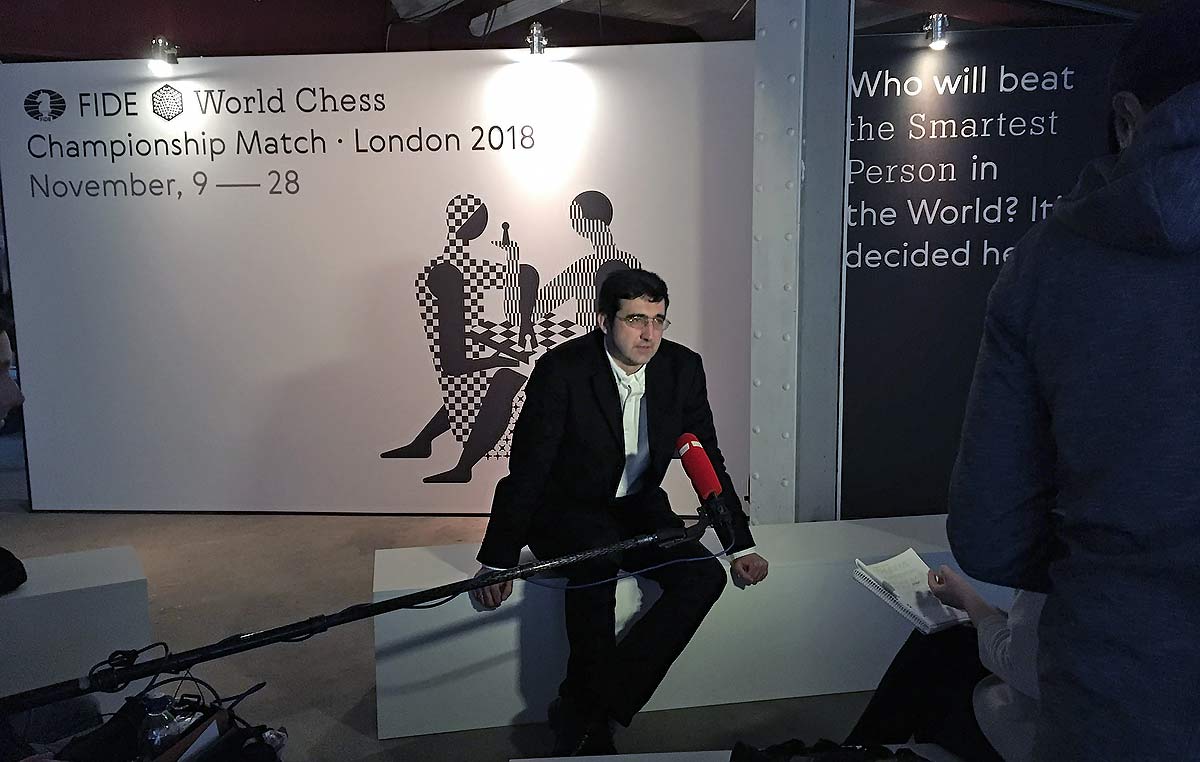
Kramnik's stamina was on display at the opening press conference, where he did multiple back-to-back interviews | Photo: Macauley Peterson
Where
Berlin is "poor, but sexy," said former mayor Klaus Wowereit. Since then it has even become more sexy. And Berlin is a big chess city, with about 50 chess clubs, including the Berlin Chess Society of 1826, the oldest existing German chess club.
For the 2015 Blitz and Rapid World Championship, the organising company World Chess diligently sold tickets and was even surprised by the crowds at the Bolle Meierei. The layout of the hall and the number of interested fans made it hard to move around at times. The new venue a the "Kuehlhaus" ("cold store") will probably be much better, with more space and fewer players. The plans specify 5000 square meters available across multiple floors.
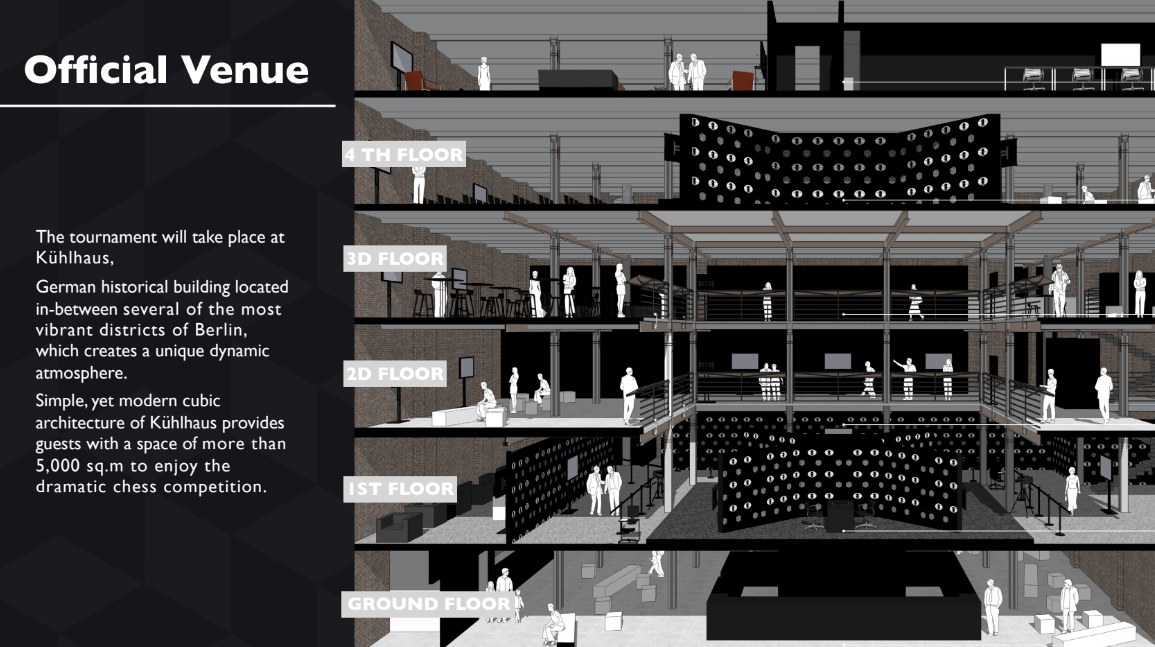
Five floors at the Kühlhaus | Photo: Worldchess
The playing hall and the spectator area looks quite futuristic. The players seem to be sitting along a cube spread around four tables on the first floor. The spectators can look down on the players from above. Seats — other than for the players — are scarce.
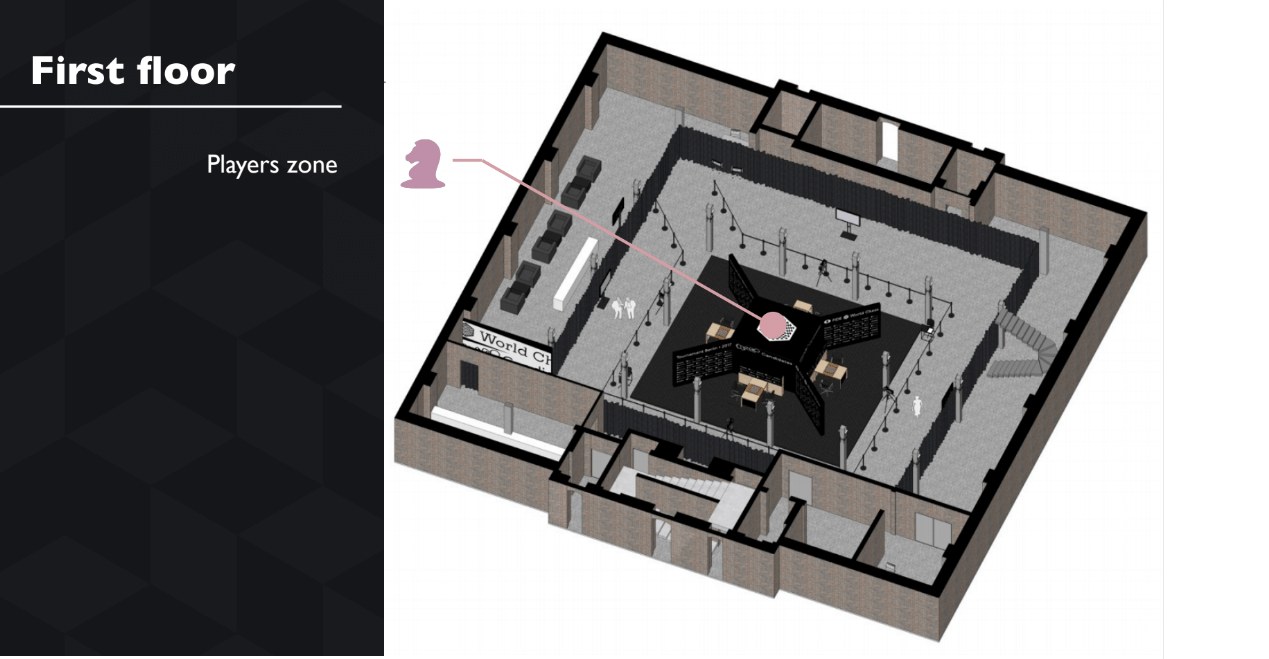
The playing hall first floor | Photo: Worldchess
On the third floor, you can watch the games on display screens, analyze and play yourself. The press conferences will be held on the fourth floor, after each day's play. The commentators will be there, too. For the international audience, Judit Polgar will be paired up with Yannick Pelletier and Lawrence Trent. For the local German-speaking audience, GM Ilja Zaragatski anchors the show, alongside a variety of co-commentators.
The fifth floor is expected to be reserved for VIP guests.
Via Ticketmaster, Agon has offered three types of cards, white, silver and gold. The prices range from about 17 Euro (White) to 107 Euro (Gold). On the first and last day, ticket prices are double, but Agon says most of the tickets are already sold out. The difference of the categories is not fully explained, but presumably, not all floors are accessible to the people in the "cheap seats".
The "cold store" was built in 1901 by the "Society for Market and Refrigerated Halls": cooling of food. The building, built in the style of the north German brick Gothic, belonged to a complex of three buildings on an area of 9000 square meters and together with these at the beginning of the 20th century was the largest refrigerated warehouse complex in Europe. The structure was made of steel and the floors were made of reinforced concrete, which was a completely new technique at that time. The complex survived the Second World War almost undamaged and served after the German division of the Berlin Senate as a warehouse for the "Senate Reserve" — a stockpile by the city of Berlin in the event of a new blockade of Berlin by the GDR and its Soviet occupying power.
In 1979, the building Kühlhaus I was demolished. Kühlhaus II remains thanks to the initiative of architect Dr.-Ing. Helmut Maier, and it was listed as a historical monument. In 2010, extensive renovations began and from 2011 the building with its seven floors has been used as a venue for various events.
Chess in Germany
Germany has been the scene of several World Championship matches and has experienced many major international tournaments throughout history. But judging by the importance of qualifying for the next match and the quality of the participating players, it is probably the highest ranking tournament that has ever taken place in German chess history.
After the Blitz and Rapid Chess World Championship 2015, FIDE's commercial partner Agon has relocated a high-class tournament to Berlin for the second time. The German capital is not only culturally one of the major European centres. This is where German chess history once began. The Berlin Chess Society, founded in 1828, is the oldest existing German chess club. Many developments in opening and endgame theory began here.
Nearly 200 years after the founding of the Berlin Chess Society, there are 49 chess clubs in Berlin with almost 2500 members.
The German Chess Federation is especially pleased about the awarding of the candidate tournament to Berlin. Because 2018 is the "Lasker's year." 150 years ago, in 1868, the only German chess world champion was born and Berlin was one of his personal chess centres. Here he went with his brother Berthold through the chess cafes, discussed with Albert Einstein on the theory of relativity and played many tournaments. Together with the Emanuel Lasker Society, the German Chess Federation is planning numerous events in memory of one of the best players of all time.
The exact location is Luckenwalder Str. 3, near the S-Bahn station Gleisdreieck and in the immediate vicinity of the Berlin Museum of Technology.
Quite central, about a kilometre south of Potsdamer Platz
When
ChessBase will have round-up videos after each round allowing you to quickly catch up on each day's action.
| Date |
Round |
Round-up webcast |
| Saturday, March 10 |
1 |
Oliver Reeh |
| Sunday, March 11 |
2 |
Daniel King |
| Monday, March 12 |
3 |
Lawrence Trent |
| Tuesday, March 13 |
Rest day |
|
| Wednesday, March 14 |
4 |
Daniel King |
| Thursday, March 15 |
5 |
Lawrence Trent |
| Friday, March 16 |
6 |
Daniel King |
| Saturday, March 17 |
Rest day |
|
| Sunday, March 18 |
7 |
Erwin l'Ami |
| Monday, March 19 |
8 |
Daniel King |
| Tuesday, March 20 |
9 |
Simon Williams |
| Wednesday, March 21 |
Rest day |
|
| Thursday, March 22 |
10 |
Simon Williams |
| Friday, March 23 |
11 |
Erwin l'Ami |
| Saturday, March 24 |
12 |
Simon Williams |
| Sunday, March 25 |
Rest day |
|
| Monday, March 26 |
13 |
Erwin l'Ami |
| Tuesday, March 27 |
14 |
Simon Williams |
| Wednesday, March 28 |
Tiebreak (if necessary) |
|
Full pairings
Available once Round 1 begins
Translation from German: Macauley Peterson
Links
